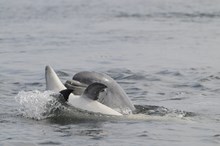28 November, 2014
World’s most northerly bottlenose dolphins stable for 23 years
The number of Scotland’s famous east-coast bottlenose dolphins using the Moray Firth Special Area of Conservation (SAC) has remained stable for nearly quarter of a century, according to the latest report published by Scottish Natural Heritage (SNH) today (Friday).
The North Sea off Scotland’s east coast is home to around 200 bottlenose dolphins. The dolphins are frequently seen in the Moray Firth, part of which is an EU-designated SAC to help protect the world’s most northerly population of this species. The popular dolphins are a big tourist attraction, generating around £4m a year for the local economy.
By studying photographs and markings on the dolphins’ fins, researchers estimated that 102 individuals used the SAC during the summer of 2011. In 2012 this figure rose to 112 and in 2013 an estimated 94 dolphins used the area. The research highlights that although there is variability in the estimated numbers of dolphins using the SAC seasonally and each year, over the long term (1990 - 2013), the numbers appear to be stable.
Despite these results, the North Sea’s only resident bottlenose dolphin population is still considered to be vulnerable. Stretching from the Moray Firth to Fife and further south, the population is relatively small and dolphins reproduce slowly. While some of the dolphins travel along the coast between these different areas, the population remains isolated.
Morven Carruthers from SNH’s marine team said: “Dolphins in the Moray Firth SAC have been the focus of intense research for many years now and over that time the numbers using the SAC appear to have remained stable. This is great news and a tribute to the people, organisations and relevant authorities around the Moray Firth who have worked to manage the many activities on the busy firth with the dolphins’ well-being in mind. Of course it’s important that we all continue to work together as the population remains vulnerable.”
SNH has a duty to report on the condition of bottlenose dolphins within the SAC every six years. The report published today is an interim report. The next full report is due in 2018, when SNH will update its assessment of the status of the Moray Firth SAC. If data allows the estimate of the overall east coast population size, which in 2006 was 195 individuals, will also be updated. The report was produced by the University of Aberdeen, who have been carrying out research on the population since 1989, in collaboration with the Sea Mammal Research Unit at the University of St Andrews.
https://www.flickr.com/photos/snh-iyb2010/sets/72157647598080100/ - all copyright Ben James/SNH
Contact information
- Name
- SNH Media
- snhmedia@snh.gov.uk
NatureScot is Scotland's nature agency. We work to enhance our natural environment in Scotland and inspire everyone to care more about it. Our priority is a nature-rich future for Scotland and an effective response to the climate emergency. For more information, visit our website at www.nature.scot or follow us on X at https://x.com/NatureScot
’S e NatureScot buidheann nàdair na h-Alba. Bidh sinn a’ neartachadh àrainneachd na h-Alba agus a’ brosnachadh dhaoine gu barrachd suim a chur ann an nàdar. Tha e mar phrìomhachas againn gum bi nàdar na h-Alba beairteach agus gun dèilig sinn gu h-èifeachdach le èiginn na gnàth-shìde. Tha an tuilleadh fiosrachaidh aig www.nature.scot no air X aig https://x.com/NatureScot

